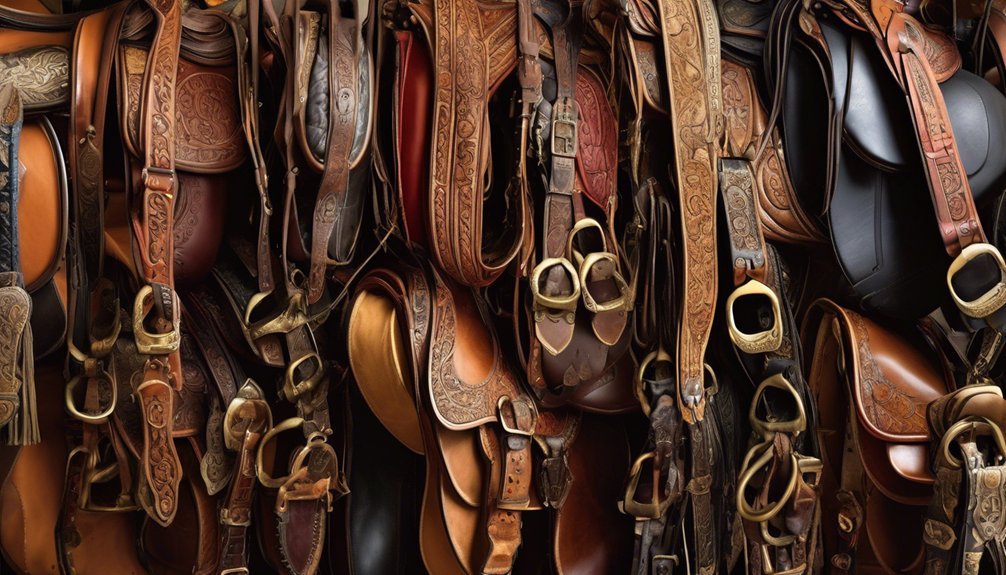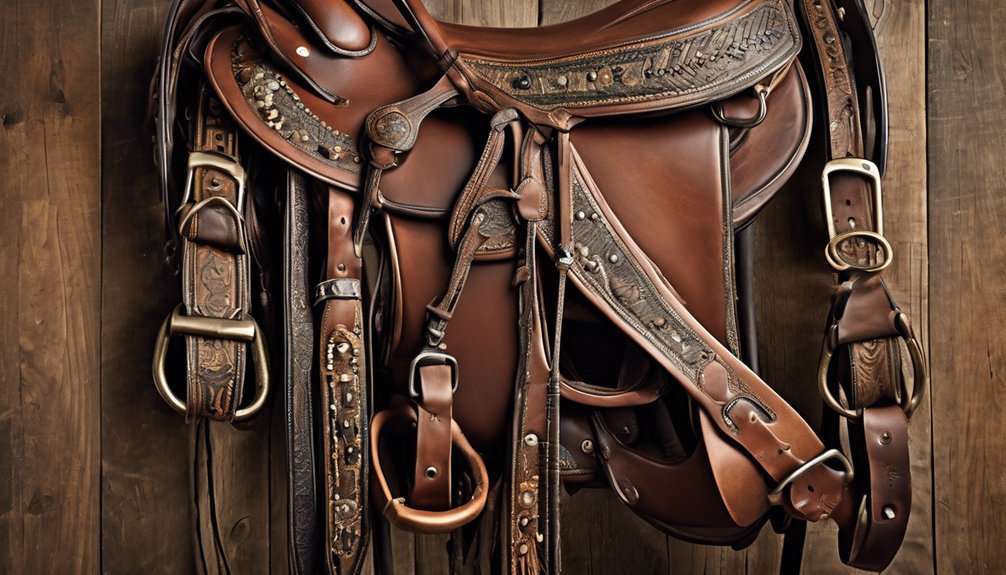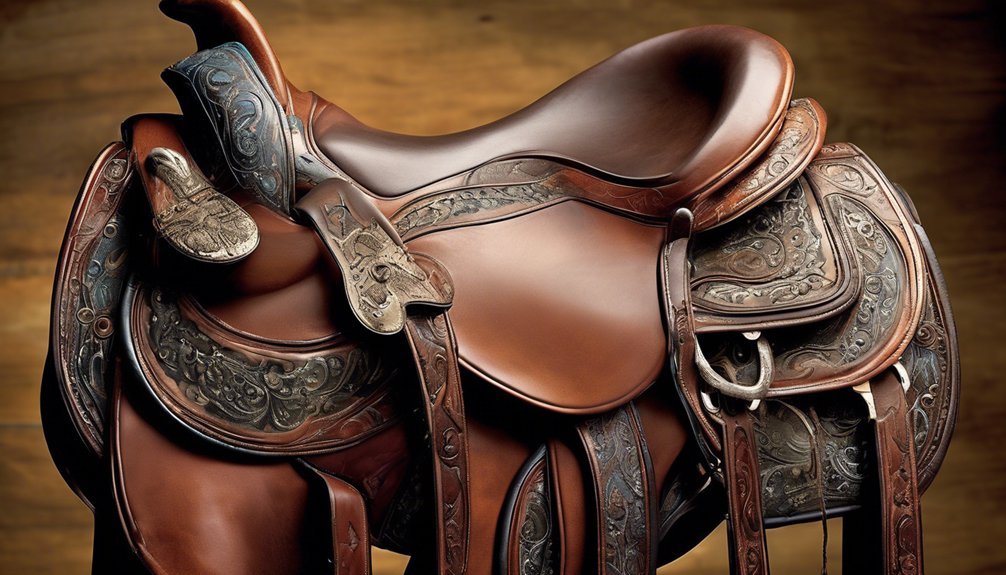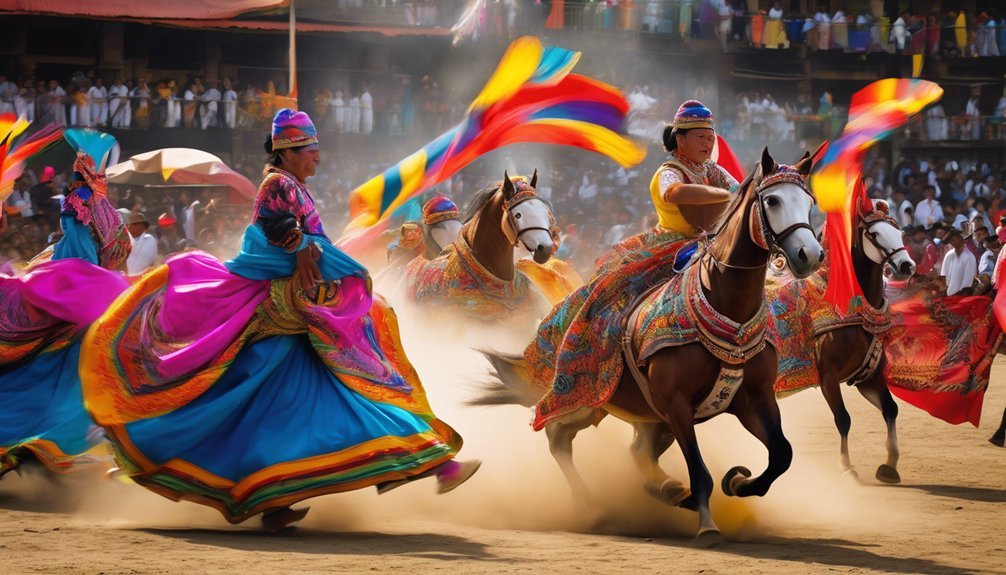
Some might argue that horse tack is simply functional, but its evolution reveals much more than practicality. From the early leather and wood designs of ancient civilizations to today's sophisticated gear made from high-tech materials, each advancement tells a story of necessity and artistry. You'll see how warfare, transportation, and cultural influences shaped this equipment, transforming it into a symbol of status and performance that continues to evolve. What might the future hold for this essential equestrian gear?
Key Takeaways
- Horse tack originated in ancient civilizations, evolving from simple leather straps to complex designs that improve horse-rider communication and control.
- Military needs influenced tack design, leading to specialized saddles and bridles that enhanced stability, comfort, and maneuverability in battle.
- Advancements in materials, such as synthetic leathers and moisture-wicking fabrics, have revolutionized tack for better durability, safety, and performance.
- Cultural symbolism is reflected in horse tack, with elaborate designs signifying status and identity, intertwining aesthetics with functionality.
- Specialized tack for various equestrian sports illustrates the evolution of horse gear, merging traditional practices with modern innovations for diverse riding experiences.
The Origins of Horse Tack in Ancient Civilizations

The origins of horse tack can be traced back to ancient civilizations, where necessity drove innovation in equestrian gear. As you explore these early societies, you'll notice how horse domestication sparked a need for effective tools that enhanced both riding and control.
From the Mesopotamians to the Mongols, each culture crafted unique gear, reflecting their environment and riding styles. You'll see how materials like leather and wood were ingeniously utilized, creating bridles and harnesses that improved communication between horse and rider.
These innovations laid the groundwork for modern tack, showcasing the deep bond humans formed with horses. Understanding this historical context enriches your appreciation for the sophisticated designs that have evolved over millennia, rooted in practical needs born from a shared journey with these majestic animals.
The Development of Saddles and Bridles Through the Ages
Throughout history, saddles and bridles have undergone significant transformations, reflecting advancements in technology and changes in riding practices.
In ancient times, you'd find simple saddle designs made of cloth or leather, which evolved into more structured forms with the addition of stirrups in the Middle Ages. These innovations enhanced rider stability and control.
Similarly, bridle types transitioned from basic leather straps to intricate designs featuring various bits and reins, catering to different riding styles and horse temperaments.
As you explore these developments, you'll notice how each change not only improved functionality but also deepened the bond between rider and horse, making each ride an intimate experience.
This evolution showcases the artistry and practicality behind these essential pieces of gear.
The Influence of Warfare and Transportation on Horse Gear
Warfare and transportation have significantly shaped the design and function of horse gear throughout history.
As you examine military innovations in tack, consider how the demands of battle led to advancements in durability and functionality, while the need for efficient movement influenced the overall design.
Additionally, cultural contexts reveal how different societies adapted their gear to suit both practical needs and aesthetic values, reflecting their unique relationships with horses.
Military Innovations in Tack
As military conflicts evolved, so too did the designs and functionalities of horse tack, reflecting the pressing demands of warfare and transportation.
You'll notice that military saddles became more specialized, offering greater stability and comfort for soldiers during combat. These innovations allowed for quick maneuvers, essential for survival in battle.
Tactical bridles, designed for enhanced control, replaced simpler designs, enabling riders to give precise commands even amidst chaos. The integration of materials like leather and metal reinforced these innovations, providing durability while maintaining flexibility.
Each change in tack mirrored strategic shifts in warfare, ensuring that both horse and rider could adapt to the ever-changing landscape of conflict. Your understanding of this evolution highlights the deep connection between horses and their roles in military history.
Transportation Requirements and Design
The evolution of horse tack was significantly shaped by the dual demands of military and civilian transportation.
As transportation innovations emerged, so did the design evolution of horse gear, reflecting both practicality and comfort.
You'll notice how these elements intertwine, enhancing the bond between horse and rider.
- Improved saddles for better weight distribution
- Sturdier harnesses for efficiency in pulling loads
- Bridle designs allowing clearer communication
- Lightweight materials for faster travel
- Adjustable fittings to accommodate various horse sizes
These changes illustrate how the needs of warfare and civilian life pushed innovators to create gear that not only served functional purposes but also fostered a deeper connection with the horse, ensuring a seamless partnership on the road.
Cultural Influences on Gear
While many may see horse tack merely as functional gear, its evolution is deeply intertwined with cultural influences stemming from warfare and transportation.
As you explore the history of horse gear, you'll notice how cultural adaptations reflect the needs and values of different societies. For instance, the robust saddles used by cavalry units contrast sharply with the more minimalist designs favored by nomadic tribes.
Regional variations emerge from these contexts, where climate and terrain shape materials and styles. As warfare demands swift mobility, designs evolve for efficiency and strength, while transportation needs spur innovations in comfort and functionality.
Understanding these dynamics gives you deeper insight into how horse tack serves as a mirror of cultural priorities through time.
The Role of Material Advancements in Tack Design

Advancements in materials have significantly transformed the design and functionality of horse tack, enhancing both performance and rider comfort.
Today, you'll find a blend of traditional craftsmanship with modern innovations that emphasize material durability and design flexibility.
Consider these key developments:
- Synthetic leathers: Offer high durability while being lightweight.
- Moisture-wicking fabrics: Keep both horse and rider dry and comfortable.
- Adjustable fittings: Allow for a personalized fit, improving safety and effectiveness.
- Shock-absorbing materials: Reduce strain on both horse and rider during movement.
- Reinforced stitching: Enhances the longevity of tack, ensuring it withstands rigorous use.
These advancements not only elevate the riding experience but also reflect a deeper understanding of equine and human needs.
Modern Innovations in Horse Tack for Performance and Comfort
As equestrian sports evolve, modern innovations in horse tack focus on maximizing both performance and comfort for horse and rider alike.
Ergonomic designs are now at the forefront, ensuring that saddles and bridles fit seamlessly, reducing pressure points and promoting better movement. You'll find that these advancements allow for a more natural alignment, enhancing your horse's agility and stamina during competitions.
Additionally, the use of synthetic materials has revolutionized tack by providing lightweight, durable options that withstand the rigors of daily use. These materials are often easier to clean and maintain, making them practical choices for busy riders.
The Cultural Impact of Horse Tack Throughout History
As you explore the cultural impact of horse tack throughout history, consider how it served not just as a functional tool but also as a symbol of status among various societies.
The intricacies of bridle design and saddle craftsmanship often reflected wealth and power, influencing social hierarchies.
Additionally, the evolution of horse tack played a crucial role in warfare, shaping military strategies and altering the course of battles.
Symbol of Status
Throughout history, horse tack has served not just a functional purpose but has also been a powerful symbol of status and wealth. The intricate designs and materials used in tack symbolize not only the rider's taste but also their social standing.
You can see this in various cultures where tack representation reflects hierarchy and power. Consider these aspects:
- Materials: Gold and silver embellishments showcase elite status.
- Design: Unique craftsmanship indicates personal wealth and artistic appreciation.
- Size: Larger, more elaborate saddles often belong to nobility.
- Functionality: Specialized tack for certain sports can signify prestige.
- Cultural Traditions: Unique regional styles represent local status and pride.
These elements emphasize how tack symbolism intertwines with identity and societal values, resonating deeply through the ages.
Influence on Warfare
The intricate designs and materials of horse tack not only reflect social status but have also played a pivotal role in shaping warfare.
When you consider the evolution of cavalry tactics, it becomes clear that the right tack can enhance a horse's performance, directly impacting battle strategies. Well-crafted saddles and bridles allow for better control, enabling riders to execute complex maneuvers during engagements.
Historical examples, like the Mongolian cavalry, highlight how innovations in tack facilitated rapid, coordinated attacks, altering the course of battles.
As you explore these influences, you'll see how the interplay between horse and rider, guided by the intricacies of tack, has defined not just individual combatants but entire armies throughout history.
Frequently Asked Questions
How Have Horse Tack Designs Varied Across Different Cultures?
Horse tack designs vary significantly across cultures, reflecting unique cultural influences and traditional techniques. You'll notice how different materials and styles embody each society's values, needs, and relationship with horses, creating a rich tapestry of equestrian heritage.
What Are the Most Common Materials Used in Modern Horse Tack?
In modern horse tack, you'll find a mix of traditional leather and synthetic materials. While leather offers durability and comfort, synthetic options provide lightweight, weather-resistant alternatives, catering to diverse rider preferences and equine needs.
Are There Any Regulations for Horse Tack in Competitive Events?
Did you know over 80% of competitive events enforce strict safety standards? Tack regulations ensure both horse and rider's well-being, requiring specific materials and designs. You must stay informed to ensure compliance and safety in your competitions.
How Do I Choose the Right Tack for My Horse?
To choose the right tack for your horse, prioritize saddle fit for comfort and performance. Explore various bridle types to ensure effective communication. Tailoring your choices enhances your bond and supports your horse's unique needs.
What Maintenance Is Required for Horse Tack to Ensure Longevity?
To ensure your horse tack lasts, adopt regular cleaning techniques, like wiping down with a damp cloth and conditioning leather. Store it in a cool, dry place, away from direct sunlight, to prevent damage.
Conclusion
In conclusion, the evolution of horse tack is nothing short of a breathtaking odyssey, transforming simple leather straps into masterpieces of engineering and artistry. You've witnessed how each advancement has not only revolutionized the equestrian experience but has also redefined the very essence of human-animal partnership. As you ride into the future, remember that the gear you use is a testament to centuries of innovation, merging comfort and performance in a dazzling display of equine elegance!





